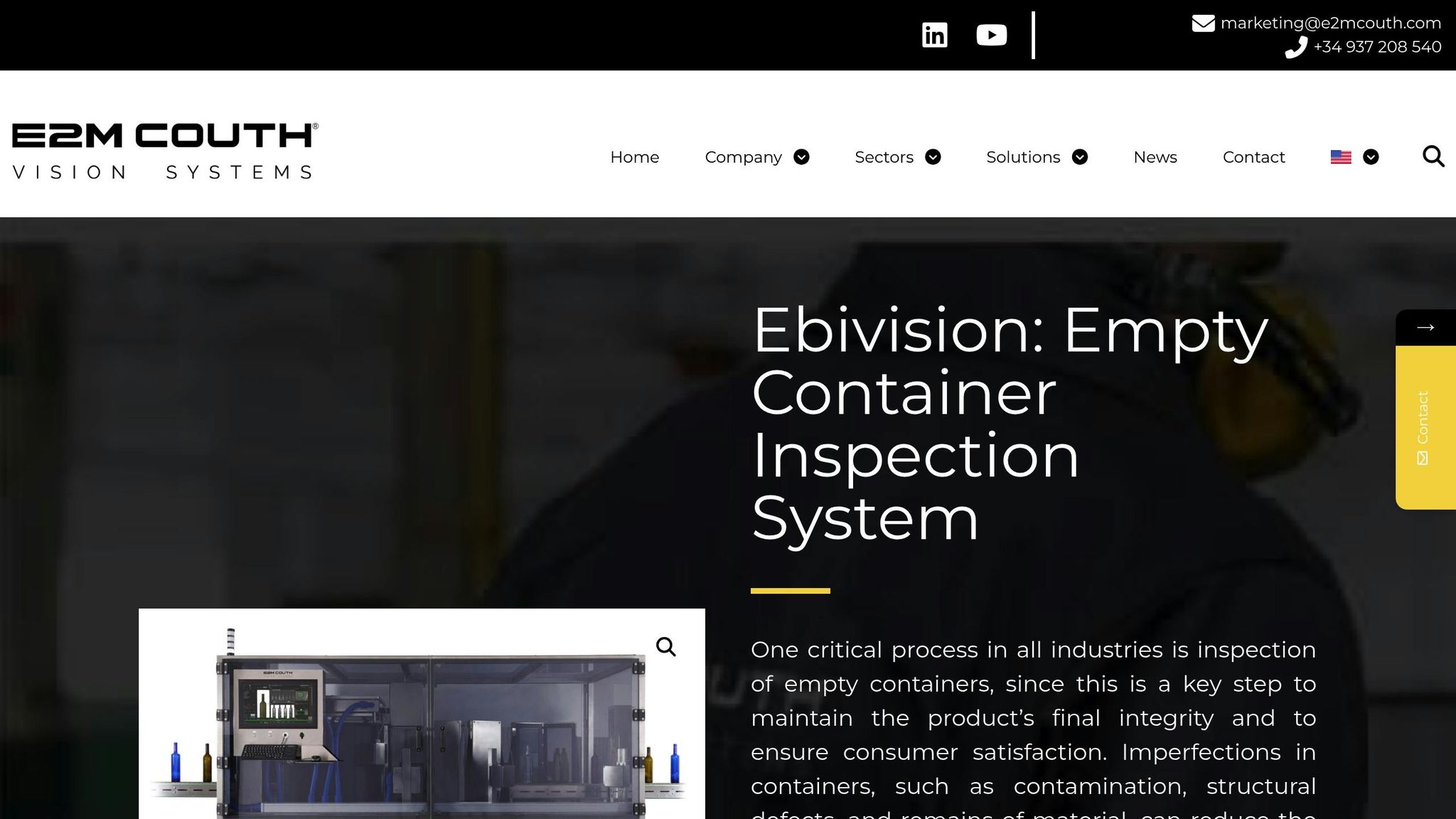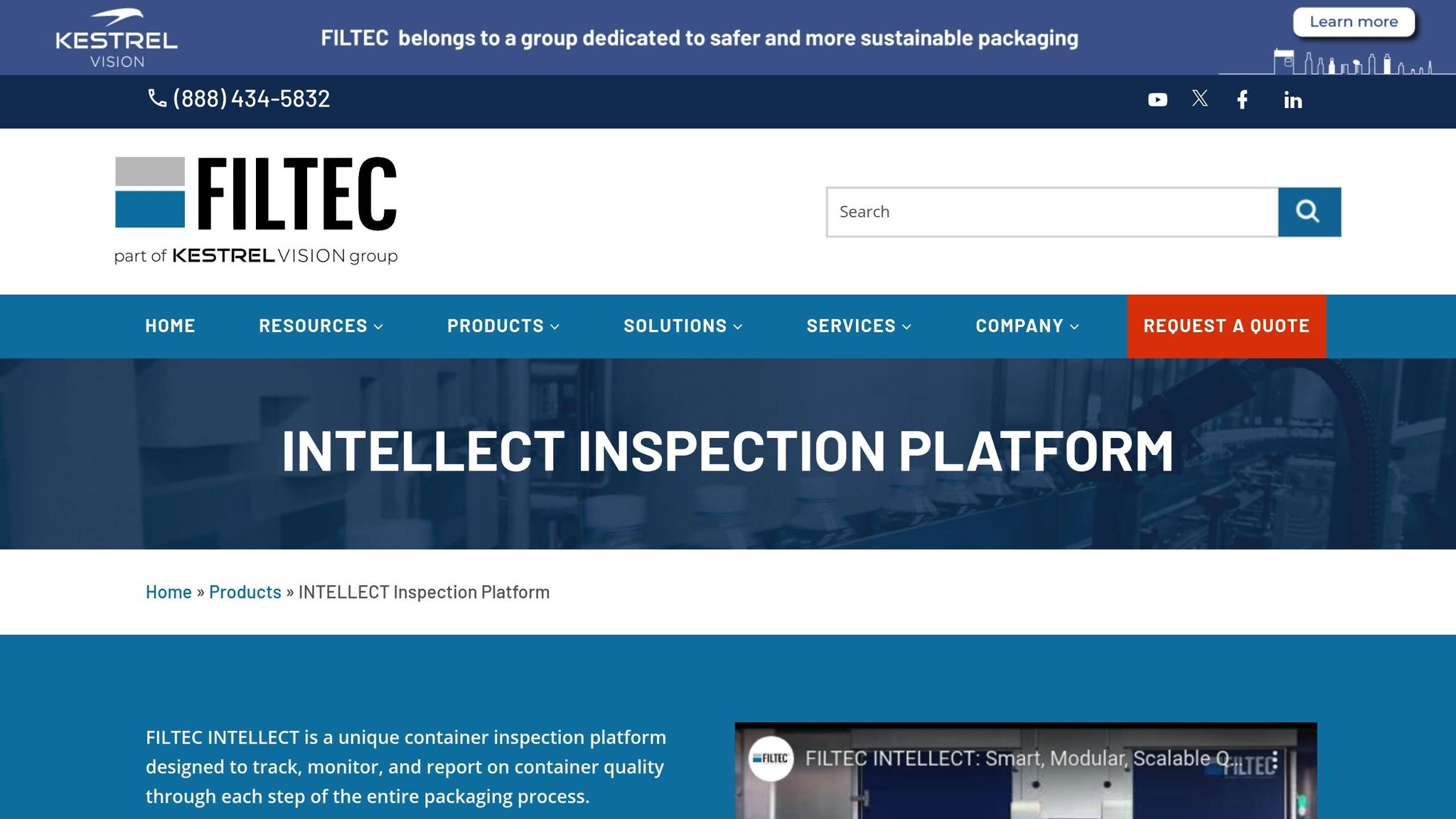 (888) 434-5832
(888) 434-5832
Advanced container inspection systems are cutting waste, saving time, and boosting efficiency in manufacturing. These technologies detect defects early, reduce disputes, and streamline processes, making them essential for quality control and waste reduction.
| Technology | Speed | Defects Detected | Automation |
|---|---|---|---|
| Vision Systems | Up to 2,400 units/min | External defects, labels | Fully automated |
| X-Ray/Gamma-Ray | Varies by density | Internal flaws, contamination | Fully automated |
| Thermal Imaging | Real-time | Seal integrity, adhesion | Fully automated |

Modern container inspection technologies are essential for reducing waste and maintaining product quality. These systems combine various methods to spot defects early, preventing material losses and ensuring smoother operations.
Vision-based inspection systems act as the first safeguard against defects, operating at impressive speeds of up to 2,400 containers per minute. Using high-resolution cameras and advanced imaging, these systems can identify:
FILTEC's INTELLECT platform takes this a step further by offering precise label verification and enhanced quality control.
While vision systems handle external inspections, radiation-based methods are used to uncover hidden internal flaws.
Radiation-based inspection methods complement vision systems by detecting issues beneath the surface. These techniques are highly effective at identifying:
These non-destructive methods are incredibly precise, making them invaluable for catching subtle defects that could otherwise lead to contamination or wasted products.
Thermal imaging technology provides real-time, non-invasive testing to ensure seal integrity. This method is particularly effective at detecting:
Thermal Seal Inspection (TSI) systems have revolutionized quality control by removing the guesswork of manual inspections. They deliver immediate feedback, allowing for quick adjustments and improved efficiency.
When combined, these technologies significantly reduce waste and save costs by seamlessly integrating into automated inspection platforms.
| Inspection Method | Speed | Defect Detection Capability | Automation Level |
|---|---|---|---|
| Vision Systems | Up to 2,400 units/min | External defects, labels, dimensions | Fully automated |
| X-Ray/Gamma-Ray | Varies by density | Internal flaws, contamination | Fully automated |
| Thermal Seal Testing | Real-time | Seal integrity, adhesion issues | Fully automated |
Implementing advanced inspection systems isn’t just about adding new technology; it’s about integrating it smartly to minimize waste and keep production running smoothly. Modern setups often combine various technologies to achieve this balance.
The key to effective integration is keeping disruptions to a minimum while improving efficiency. The INTELLECT platform achieves this with its modular design, which allows inspection components to be strategically placed along the production line. This setup ensures smooth communication between stations and reduces the overall equipment footprint. Operators can also access quality metrics and controls instantly through a 19-inch touchscreen interface.
"FILTEC INTELLECT is a unique container inspection platform designed to track, monitor, and report on container quality through each step of the entire packaging process."
These integration features work hand-in-hand with the platform’s advanced monitoring capabilities.

The INTELLECT system offers powerful tools to monitor and address quality issues before they escalate. Here’s a breakdown of its key monitoring features:
| INTELLECT Monitoring Features | Purpose | Waste Reduction Impact |
|---|---|---|
| Continuous Statistical Analysis | Tracks production patterns and detects anomalies | Helps identify systematic problems early |
| Individual Valve Performance | Monitors filler valve efficiency | Reduces overfilling and product waste |
| Closure Inspection | Evaluates capper head operation | Prevents faulty seals |
| Label Verification | Ensures correct label placement | Avoids packaging errors |
With real-time data collection, operators can quickly adjust processes to prevent defective products from being made. This proactive approach not only maintains quality but also reduces waste.
Using data to plan maintenance can significantly extend equipment life while cutting down on waste. Smart maintenance strategies have shown impressive results, including:
"Scheduled maintenance checks and servicing is now a thing of the past as the data helps us determine precisely when and where maintenance is needed. We can now actively anticipate and prevent equipment breakdowns which means equipment is more likely to last its specified lifespan and we don't have to resort to costly fixes or replacements." - Damien Stacey, National Capital & Planning Manager, QICGRE
A strong maintenance plan should combine preventive and predictive strategies, such as:
Sophisticated container inspection systems are proving their worth by driving measurable reductions in waste. They achieve this by improving key metrics tied to quality, material usage, and operational efficiency.
Quality issues can take a big bite out of profits, costing manufacturers anywhere from 5% to 30% of their income due to repairs, rework, inspections, recalls, and customer complaints. The INTELLECT platform helps tackle this head-on by offering real-time monitoring that pinpoints problems as they occur, allowing for immediate corrective action.
"Lean methods focus on continually improving resource productivity and production efficiency, which frequently translates into less material, less capital, less energy and less waste per unit of production."
– Environmental Protection Agency (EPA)
By addressing quality problems early, manufacturers not only improve their pass rates but also save on materials and costs.
Catching defects early is a game changer. It minimizes material waste and helps companies move closer to achieving Zero Defect and Zero Waste objectives. Some of the standout benefits include:
These inspection systems don’t just save on materials - they also make operations more energy-efficient. By dynamically adjusting settings based on production demand, they optimize power usage without sacrificing performance. A pharmaceutical manufacturer, for example, managed to cut changeover times by 30%, which in turn significantly reduced material waste.
By blending cutting-edge technology with streamlined processes, advanced inspection systems are transforming the way industries manage quality control and efficiency.
For instance, container inspection systems equipped with machine vision, X-ray, and thermal imaging technologies significantly cut down industrial waste. A single DI-100 LT/XL machine can take the place of up to five manual operators, reducing waste and making better use of resources.
The role of FILTEC's INTELLECT platform further highlights the power of data-driven insights. As Matthew Trowbridge, FILTEC's Chief Commercial Officer, explains:
"INTELLECT seamlessly integrates with our inspection modules to uncover critical data about a line's performance. This makes it easier than ever to improve performance, reduce waste, and deliver optimal products at the point of sale." – Matthew Trowbridge
From a financial perspective, the investment in inspection systems, ranging between $25,000 and $135,000, is minimal compared to the potential costs of a single product recall.
Modern inspection systems deliver clear advantages, including:
This forward-thinking approach not only enhances operational efficiency but also supports sustainable manufacturing practices. Advanced inspection systems are proving to be essential tools for reducing waste, protecting the environment, and driving business success.
Advanced container inspection systems play a key role in cutting down waste in manufacturing by spotting defects early and ensuring only top-quality containers make it through. Using machine vision and AI-powered algorithms, these systems can identify issues like cracks or irregular shapes before the containers are filled. This prevents unnecessary waste of materials and resources caused by defective products.
Automating the inspection process offers manufacturers several benefits: it reduces scrap, minimizes rework, and brings down operational costs. Catching defects early also keeps production running smoothly, helping businesses maintain efficiency while consistently delivering high-quality products to the market.
In the world of container inspection, three main technologies stand out, each offering distinct advantages based on specific needs:
Choosing the right technology comes down to the specific inspection needs and the demands of the production process. Each method has its place in ensuring quality and safety.
The INTELLECT platform enhances inspection systems by delivering real-time data analytics, which allows for quicker and more precise defect detection. Its ability to connect effortlessly with factory equipment ensures it integrates smoothly into existing production lines, while its user-friendly interface makes monitoring and control straightforward.
Designed with a flexible, modular structure, the platform fits seamlessly into different production setups, helping businesses improve quality control and minimize waste. By automating essential tasks and offering actionable insights, INTELLECT boosts operational efficiency while promoting more sustainable industrial practices.
In beverage and liquid products manufacturing, precision is...
Call us today! (888) 434-5832
Request a Quote